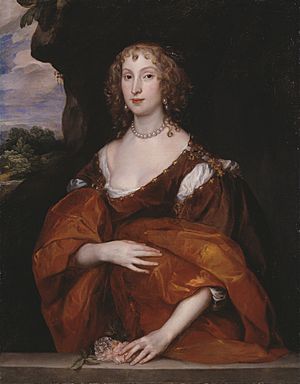William Killigrew (1606–1695) facts for kids

Sir William Killigrew (born 1606, died 1695) was an important English official who worked for King Charles I and King Charles II. He lived at Kempton Park in Middlesex.
William was the son of Sir Robert Killigrew and Mary Woodhouse. He was also the older brother of Thomas Killigrew. William married Mary Hill, and they had three sons: Henry, William, and Sir Robert. Their daughter Elizabeth married Francis Clinton, the 6th Earl of Lincoln.
Contents
Early Life and Public Service
William Killigrew became a knight in May 1626. This was an honor given by the King.
Member of Parliament
In March 1628, he was chosen to be a Member of Parliament (MP) for two areas in Cornwall: Newport and Penryn. An MP is someone elected to represent their local area in the country's government. He ended up serving only for Penryn.
Pendennis Castle Governor
In 1629, William and his father were both made governors of Pendennis Castle. This was an important castle that protected the coast. However, after some problems, William gave up his role in 1635. Sir Nicholas Slanning took over as governor.
Land in Bermuda
In 1634, William Killigrew leased some land in Bermuda to his uncle, Henry Woodhouse. The rent was quite unusual: 100 oranges, 100 lemons, and 100 potatoes each year! But his uncle did not keep up with the payments. So, in 1637, William took the land back.
Draining the Fens
William Killigrew also tried to drain the Fens in Lincolnshire. This was a huge and very expensive project. It meant removing water from marshy land to make it suitable for farming. This project caused a lot of arguments with local people.
English Civil War Support
During the English Civil War, William Killigrew was very loyal to the King. He gave strong support to King Charles I.
Attempted Ambassador Role
In 1646, he tried to become the King's ambassador to Constantinople. An ambassador is a country's official representative in another country. However, the company he approached, the Levant Company, did not choose him for the role.
After the King Returned
When King Charles II returned to the throne in 1660 (an event called the Restoration), William Killigrew received an important job. He was made the Queen's Vice-Chamberlain. This was a powerful and well-paid position in the Queen's household.
Financial Ideas
In 1663, Killigrew published a book with an interesting idea. He suggested that the government could make money by selling special "bonds." These bonds were like IOUs (I Owe You) that people could buy. The government would pay interest on them. His idea was to help the country earn money and avoid relying too much on wealthy bankers.
The government did try out his idea. However, over time, many of these bonds ended up in the hands of a few powerful bankers. This actually made the bankers even more powerful.
Member of Parliament Again
From 1664 to 1679, William Killigrew served as a Member of Parliament again. This time, he represented Richmond in Yorkshire.
William Killigrew as a Playwright
Sir William Killigrew was also a writer. He wrote four plays that were quite good for their time.
- Ormasdes, or Love and Friendship (published 1664)
- Pandora, or the Converts (published 1664)
- Selindra (published 1664)
- The Siege of Urbin (published 1666)
Many people thought The Siege of Urbin was his best play. It was a type of play called a tragicomedy, which mixes sad and funny parts. The poet Edmund Waller even wrote verses about Killigrew's play Pandora. This play was first written as a tragedy, but it didn't do well. So, Killigrew changed it into a comedy.



